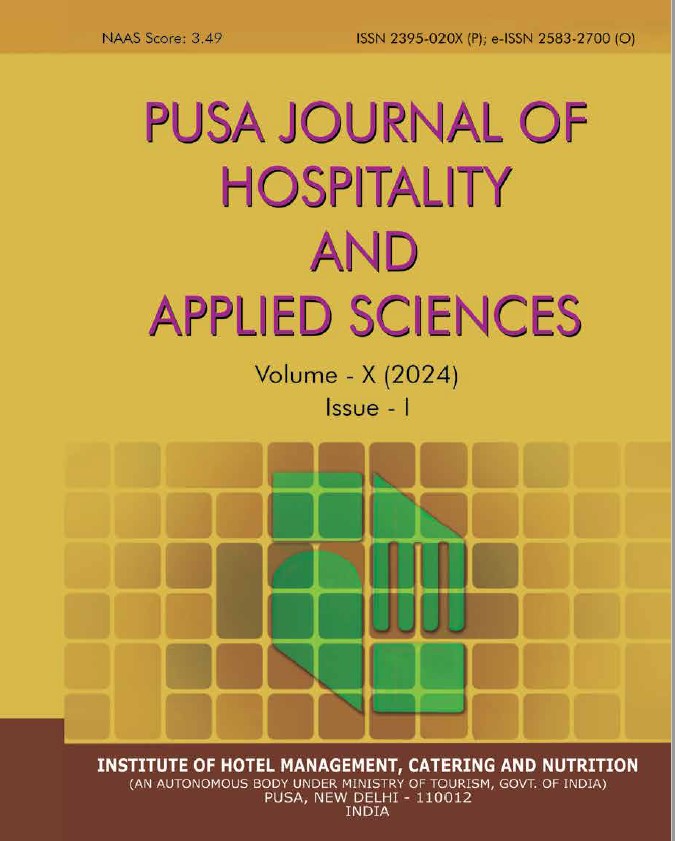Development Of Muffin With Diabetic Friendly Ingredients
Keywords:
Diabetic Muffin, Dates, Flaxseed, Buckwheat, Glycemic Index, FiberAbstract
Background: Diabetes is one of the major health problems is the world. India is considered as the diabetic capital of the world. It commonly occurs in middle adulthood (45-60 years), people suffering from diabetics often have craving of having something sweet but cannot have it as their ingredients have a high Glycemic Index and low in fibre content, which instantly leads to rise in the blood glucose level in the body and can further lead to worsening of the symptoms. Developing bakery goods with healthier alternative can benefit diabetic people to overcome the craving this craving. Objective: The work was conducted to develop muffins with diabetic friendly ingredients and to conduct its sensory, nutritive and microbial analysis. Methodology: Experimental study was conducted to develop healthier variety of muffins which is one of the most commonly consumed bakery product. The work was conducted in the laboratory of Institute o f Hotel Management, Pusa, New Delhi. The base ingredients used were Buckwheat, Flaxseed and Dates. On finalization of the product nutritive value, sensory evaluation on 5-point hedonic scale by trained panel (n=5) and semi trained panel (n=25) and 3 days shelf life estimation of the developed product was done. Results: The final product was made by using buckwheat and refined flour (50%), flaxseed and dates. The nutritive value of the product as per 100 grams was energy (505 Kcal), protein (9.4 gm), carbohydrate (36.84 gm), fat (32.96 gm) and total dietary fibre (6.58 gm). For overall acceptability of the product majority (80%) of trained panel extremely liked the product and majority (56%) of semi trained panel extremely liked and 32% neither liked or disliked the product. Conclusion: The craving for sweet cannot be a danger if healthy alternatives are made a part of days meal. Inclusion of healthy ingredients in tempting snacks or products can be beneficial for people suffering from lifestyle disorders.
References
Amer, W. M. (1994). Taxonomic and Documentary Study of Food Plants in Ancient Egypt. Doctoral Dissertation, Cairo University. https://www.scirp.org/(S(351jmbntvnsjt1aadkposzje))/ reference/ReferencesPapers.aspx?ReferenceID=559875.
Bernacchia, R., Preti, R., & Vinci, G. (2014). Chemical composition and health benifits of flaxseed. Austin Journal of Nutrition and Food sciences, 2(8), 1045.
Bhaduri, N.P., & Prajneshu, M. (2016). Kuttu (Buckwheat): A Promising Staple Food Grain for our Diet. Journal of Innovation for Inclusive Development, 1(1), 43-45.
Bhardwaj, K., Verma, N., Trivedi, R. K. & Bhardwaj, S. (2015). Flaxseed Oil and Diabetes: A Systemic Review.Journal of Medical Sciences, 15(3), 135-138.
Chao, C. C. T., & Krueger, R. R. (2007). The date (Phoenix dactylifera L.): Overview of biology, uses, and cultivation. Hortscience, 4(5), https://doi.org/10.21273/ HORTSCI.42.5.1077.
Dalal, T. (2021). https://m.tarladalal.com/calories-for-buckwheat-moong-and-vegetable khichdi-healthy-kuttu-vegetable-khichdi-3506.
Glatter, R. (2014, March 17). Benefits of a low glycemic approach to eating. Retrieved from https://www.forbes.com/sites/robertglatter/2014/03/17/benefits-of-a-low-glycemic approach-to-eating/?sh=162a74946fa3.
Greger, M. (2013). Flaxseed for Diabetes. Retrived from hhtps://nutritionfacts. org/2013/10/08/flaxseeds-for-diabetes/
IDF Diabetes Atlas (2019) 9TH Edition. https://www.idf.org/e-library/epidemiology-research/ diabetes-atlas/19-atlas-6th-edition.html.
Jeppesen, C., Schiller, K., & Schulze, M. B. (2013). Omega-3 and omega-6 fatty acids and type 2 diabetes. Current Diabetes Report, 13, 279-288.
Khanna, K., Gupta, S., Passi, S. J., Seth, R., Mahna, R., & Puri, S. (2016). Textbook of Nutrition and Dietetics. New Delhi : Elite Publishing House Pvt. Ltd.
Longvah, T., Ananthan, R., Bhaskarachary, K., & Venkaiah, K. (2017). Indian Food Composition Tables. National Institute of Nutrition. ICMR. Department of Health Research. Ministry of Health and Family Welfare. Government of India.
Morris, D. H. (2007). Flax: A Health and Nutrition Primer. Flax Council of Canada. https:// flaxcouncil.ca/resources/nutrition/technical-nutrition-information/flax-a-health-and-nutrition primer/ https://flaxcouncil.ca/wp-content/uploads/2015/03/FlxPrmr_4ed_Chpt1.pdf
Rainey, C. J. (2016) California Dates have a Low Glycemic Index as determined by both in vitro and in vivo methods. The Faseb Journal, https://faseb.onlinelibrary.wiley. com/doi/abs/10.1096/fasebj.30.1_supplement.1160.7 https://doi.org/10.1096/fasebj.30.1_ supplement.1160.7.
Rizkalla, S.W., Bellisle, F., & Slama, G. (Dec, 2002). Health benfits of low glycemic index foods, such as pulses in diabetic and healthy individuals. British Journal of Nutrition, 88 (Suppl 3), S255-62. doi: 10.1079/BJN2002715.
Shahib, A. W., & Marshall, R. (2003). The Fruit of the Date Palm: Its Possible Use as the Best Food for the Future. International Journal of Food Sciences and Nutrition, 54(4), 247- 59. doi: 10.1080/09637480120091982.
Sheth, A. & Sengupta, R. (2015) Muthiya for diabetes-A Modified Food Product. International Journal of Food and Nutritional Sciences, 4(4), 208-211.
Zielinski, H., Michalska, A., Benavent, M. A., Castillo, M. D., & Piskula, M. K. (2009). Changes in protein quality and antioxidant properties of buckwheat seeds and groats induced by roasting. Journal of Agriculture and Food Chemistry, 57(11), 4771-4776.
Zohary, D., Hopf, M., & Weiss. E. (2012). Domestication of plants in the old world. The origin and spread of domesticated plants in South-West Asia, Europe and Mediterrarean Basin 2nd edition. Oxford: Clarendon. Published to Oxford Scholarship Online: May 2015 Print ISBN 13: 9780199549061DOI:10.1093/acprof:osobl/9780199549061.001.0001 https://oxford. universitypressscholarship.com/view/10.1093/acprof:osobl/9780199549061.001.0001/ acprof-9780199549061.




